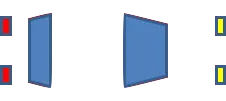我想知道在R中是否有任何包可以使用x、y坐标和形状大小来绘制类似于以下内容的图形:

我有车辆前方中心点的坐标和它们的尺寸(长度和宽度)。
编辑
这是原始数据集的样子:
> head(df)
Vehicle.ID Frame.ID Global.X Global.Y Vehicle.Length Vehicle.width Lane Preceding.Vehicle.ID Following.Vehicle.ID Spacing Headway
1 2 43 6451214 1873261 14.5 4.9 2 0 13 0 0
2 2 44 6451217 1873258 14.5 4.9 2 0 13 0 0
3 2 45 6451220 1873256 14.5 4.9 2 0 13 0 0
4 2 46 6451223 1873253 14.5 4.9 2 0 13 0 0
5 2 47 6451225 1873250 14.5 4.9 2 0 13 0 0
6 2 48 6451228 1873247 14.5 4.9 2 0 13 0 0
ff <- subset(df, Frame.ID==500)
qplot(x=Global.X, y=Global.Y, data=ff)
所有这些点都是车辆的前部中心坐标。我不知道如何显示每个车辆的长度和宽度,并标记间隙值。


rect()函数可能会满足你的所有需求... - Ben Bolker